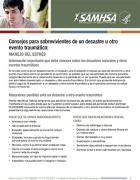This tip sheet explores stress and compassion fatigue, as well as signs of distress after a disaster. It identifies ways to cope and enhance resilience, along with resources for more information and support.
Dashboard: Filter Bricks
Main page content


This flyer highlights key Psychological First Aid concepts and resources disaster responders and outreach workers may use when assisting individuals affected by the pandemic. It also provides resources for further assistance.

This flyer provides information and tips for coping during a pandemic as well as resources for additional assistance.

Cómo hacer frente a una emergencia en la que es necesario refugiarse en sitio
Esta hoja de consejos contesta algunas preguntas frecuentes sobre cómo hacer frente a una emergencia que requiera que usted se refugie en el sitio donde se encuentre. Ofrece consejos para lidiar con la situación; explica las reacciones comunes a tener que refugiarse en sitio; da consejos sobre cómo cuidar su salud mental y la de su familia; y proporciona recursos útiles adicionales.

This fact sheet provides tips for coping with sheltering in place. It explains common reactions when sheltering in place, and provides recommendations for caring for oneself and the family.

In a disaster, it's essential that behavioral health responders have the resources they need—when and where they need them. The free SAMHSA Disaster App offers first responders immediate access for any type of traumatic event at every phase of response, including pre-deployment preparation, on-the-ground assistance and post-deployment resources.
With the SAMHSA Disaster App, first responders can:
- Access resources including tip sheets; guides for responders, teachers, parents, and caregivers; and a directory of behavioral health service providers in the impacted area.
- Download information on your phone before deployment in case of limited Internet connectivity in the field.
- Review key preparedness materials to help you provide the best support possible.
- Send information to colleagues and survivors via text message, email, or transfer to a computer for printing.
- Find interventions to help survivors of infectious disease epidemics.
Find SAMHSA’s disaster response information as a publication. Download the SAMHSA Disaster Kit.
For more information, email SAMHSA at samhsainfo@samhsa.hhs.gov

Da consejos sobre cómo prevenir y manejar el estrés cuando se debe enfrentar los efectos del trauma, la violencia masiva, o el terrorismo. Tiene una lista de consejos para aliviar el estrés, describe cómo saber cuándo buscar ayuda profesional y contiene una lista de otros recursos donde obtener ayuda o información.

Sugerencias para hablar con niños y jóvenes y ayudarlos a hacer frente después de un desástre o un evento traumático: una guía para padres, cuidadores y maestros
Es un recurso útil para que usen los padres, cuidadores y educadores después de un desastre o un evento traumático. Explica cómo ayudar a los niños y jóvenes hacer frente a estos eventos y además contiene una lista de recursos útiles.

This fact sheet offers tips for preventing and managing stress when dealing with the effects of trauma, mass violence, or terrorism. It lists tips for relieving stress and seeking professional help.

This brochure explains the Crisis Counseling Assistance and Training Program's emergency mental health services and programs for people who have experienced traumatic events. It helps states, territories, and federally recognized tribes prepare grant applications for funding.
Displaying 1 - 10 out of 12

